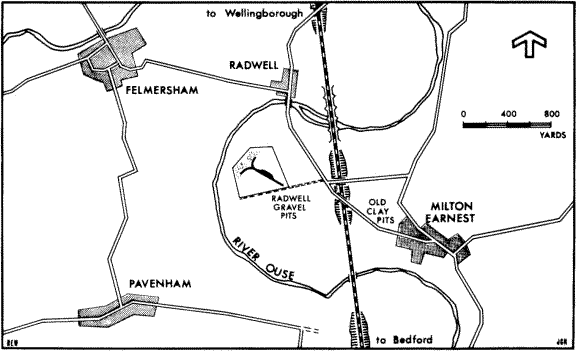
| THE INDUSTRIAL RAILWAY RECORD |
© DECEMBER 1968 |
|
INDUSTRIAL RAILWAYS |
|
| OF BEDFORDSHIRE |
A. J. WARRINGTON |
(3) RADWELL GRAVEL PITS, Near MILTON ERNEST
This 2ft 0in gauge tramway was discovered purely by accident in 1961 when I was searching for the Radwell Miniature Railway and found the rusty remains of some derelict tip wagons at the end of a cart track off the Milton Ernest to Radwell road. The pits were owned by C.V. Ibbett of Milton Ernest and were excavated during the 1940/41 winter to supply gravel for urgent Air Ministry construction work at the nearby Thurleigh Airfield. Under normal conditions a tramway would not have been used, and this method of conveyance was resorted to only because of the wet nature of the site and the urgency of the demand. The line began at the end of the cart track mentioned above and ran in a northwesterly direction across a field to the pits, a distance of some two hundred and fifty yards. There was a passing loop about halfway along the line, and on reaching the pits the line forked into two short branches to the working faces.

Two diesel locomotives were hired from Motor Rail Limited of Bedford and were returned to the makers about 1942. The works numbers of these locomotives are not known as Motor Railís records for that period have been destroyed. However, their hire fleet at that time consisted of 2Ĺ ton petrol-engined vehicles numbered between 7000 and 7099, and similar machines having Dorman 2HW diesel engines, the serial numbers of which commenced at 7100. All the petrol-engined vehicles were converted to diesel and were gradually sold off between 1950 and 1963. There were about a dozen steel side-tipping wagons, used in two lots of six, which carried a cubic yard of gravel apiece. The track was of standard "Jubilee" type - flat-bottomed rail bolted to steel sleepers.
When working ceased the track and sound wagons were sold and the locomotives returned to Motor Rail. However five wagons remained derelict in a hedge near the site of the line together with a length of rail and a steel sleeper until 1963 when they too were cut up for scrap.
Today the course of the line across the field can be seen clearly and the flooded workings support a profusion of wild life, but otherwise all is quiet and little else remains.